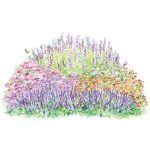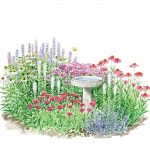WHAT SHOULD I PLANT? KNOWING WHAT YOU CAN PLANT IS A GREAT STARTING POINT FOR LANDSCAPE DESIGN.
You need to understand your growing conditions to plan and install a successful flower garden.
GETTING STARTED
Are you wanting to plant a garden but unsure of where to start? Or, perhaps, you’re feeling overwhelmed by the sheer number of beautiful shrubs, flowers, vines and other plants you see on the internet. A theme garden could be a great place to start.
Theme gardens are designed with a purpose. Flowering theme gardens can be used to attract butterflies and other pollinators, provide your home with a continuous supply of beautiful flowers (cutting garden), provide food for birds in all four seasons, or simply beautify an area of your property.
Before starting any garden, you need to evaluate your growing conditions and if/how you can improve them if needed.
Sun, soil and water are the three things all plants need to thrive. (Of these, sun exposure is the most difficult to alter.) Fortunately, all plants come tagged with their sun, soil and water requirements, so your job is to match the plant to the location that meets its specific needs achieve your goals.
You might start with a small plot, expanding over time. The advantage is you won’t feel overwhelmed at the outset, and you’ll learn as you go. The great thing about a garden is that it’s a living, growing, ever-changing canvass of creative expression. If a plant’s not thriving in a given spot, move it.
Experiment, play, have fun. And enjoy the fruits of your labor as you watch your garden grow!
 Butterfly/Pollinator Gardens
Butterfly/Pollinator Gardens
The key to attracting butterflies, bees, and hummingbirds to your garden is to offer a steady supply of nutritious, delicious foods throughout the entire growing season. Butterflies and other pollinators like to bask in the sun and some of their favorite wildflowers grow best in full or partial sun with some protection from the wind. Milkweed and wildflowers native to our area and your soil and light conditions. Native plants are the ideal choice because they require less maintenance and tend to be heartier. Pollinators need nectar early in the spring, throughout the summer and even into the fall. Choosing plants that bloom at different times will help you create a bright and colorful garden that both you and pollinators will love for months!
 Bird Attractor Gardens
Bird Attractor Gardens
Birds need food, water, and shelter to fulfill their basic needs. A water source (birdbath or pond) and bird feeders are great, but you will attract a greater variety of birds by planting trees, bushes, and flowers that create a bird-friendly landscape for them to enjoy. Native plants are most beneficial as they are best adapted to the weather extremes of our climate. They also provide a familiar place for our local bird species, and require less maintenance because they are uniquely adapted to the local climate. Selecting a mix of plants to fill a variety of needs will give you the best chance at enticing birds to your yard. Seed-producing flowers are a welcome food source, while thorny bushes like hawthorn or raspberry offer beneficial nesting sites. Evergreens and berry-producing shrubs are also beneficial.
 Cutting Gardens
Cutting Gardens
A cutting garden is a good way to ensure lots of fresh cut flowers for your home. Best to plant in a sunny location, and perhaps in a spot that’s not a focal point, such as alongside your garage or an out-of-the way patch. Choose a variety of perennials and annuals, and don’t forget to include flowering and non-flowering shrubs, since beautiful greens make for lovely arrangements as well. Select a variety of flower colors and shapes, height and texture for greater variety.
 Shade Gardens
Shade Gardens
Shade gardens can be lovely, tranquil oases of cool colors, and calming places of rest … for your eyes as well as for birds, squirrels and other creatures. Shade gardens aren’t attention grabbers; they can’t support the vivid-colored flowering plants and shrubs that thrive in sunny spots. Their charm is of the quiet, ethereal variety. If you have a shade or part-shade area, embrace it for what it is. One of several advantages of shade gardens is that, once fully established, plants can go longer without watering. Also, generally, shade plants seem to require less maintenance, including weed pulling.
Click here for some plant selection suggestions for your theme garden.

